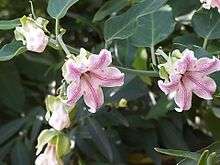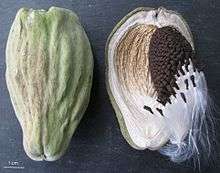Araujia sericifera
Araujia sericifera is a perennial vining plant in the genus Araujia, of the family Apocynaceae. The species was described in 1817 by the Portuguese botanist Félix Avelar Brotero. The synonym Araujia hortorum is in more frequent use in New Zealand.[2][3] Its common names include moth plant, white bladderflower, common moth vine, cruel vine and false choko.
| Araujia sericifera | |
|---|---|
 | |
 | |
| Scientific classification | |
| Kingdom: | Plantae |
| Clade: | Tracheophytes |
| Clade: | Angiosperms |
| Clade: | Eudicots |
| Clade: | Asterids |
| Order: | Gentianales |
| Family: | Apocynaceae |
| Genus: | Araujia |
| Species: | A. sericifera |
| Binomial name | |
| Araujia sericifera Brot. | |
| Synonyms[1] | |
| |
Etymology
The genus name (Araujia) derives from António de Araújo e Azevedo, 1st Count of Barca (1754–1817), a Portuguese amateur botanist who conducted scientific studies and experiments in his own botanical garden. The species' Latin name sericifera means "silk-bearing" and refers to the silky hairs surrounding the seeds inside the fruits. Araujia sericofera is an incorrect taxonomic synonym for Araujia sericifera.[4][5][6]
Description
Araujia sericifera is a creeping vine that can climb up to 5–7 metres (16–23 ft) high. When broken it releases a milky, smelly exudate. Leaves are opposite, dark green, glossy and quite fleshy, almost triangular, with entire margins, about 10–12 centimetres (3.9–4.7 in) long.
The twining stems bear plenty of fragrant, chalice-shaped bisexual flowers, about 2 centimetres (0.79 in) in diameter, with five white, creamish, violet or pale pink petals. The flowers are usually pollinated by moths (hence the common name "moth plant"), butterflies and bees (entomophily), but they are capable of automatic self-pollination. The structure of the flower includes a number of wedge-shaped openings that occasionally and inadvertently trap the pollinator's proboscis, leading to its death. The flowering period extends from July through September in the northern hemisphere and from November through February in the southern hemisphere.
The pear-shaped fruits are large pods, about 8–10 centimetres (3.1–3.9 in) long. They contain numerous black seeds attached to silky hairs that enable them to be dispersed by the wind. The fruits externally resemble those of chayote or choko (Sechium edule), hence the name false choko.
The fast-growing vines can cover a tree canopy in two or three years, competing with the tree for light, water, and nutrients. They damage trees by this competition and by twining so tightly around their branches that it girdles them.[7]
Distribution
The plant is native to South America. It was introduced to Europe and other areas as an ornamental plant, but it is now considered a noxious weed. Nowadays its geographical distribution includes southern Europe, South Africa, North America (California, Georgia), South America (Argentina, Brazil, Paraguay, Uruguay), Australia and New Zealand.[8][9]
Habitat
These plants grow in wastelands with trees and hedges, in forests and in rocky places or cliffs. They prefer sunny or partially shady places, at an altitude of 0–1,800 metres (0–5,906 ft) above sea level.
Butterflies
The plant can be used as an alternative food source for caterpillars of the monarch butterfly.[10][11] Although monarch caterpillars are not known to occur naturally on the plant, they will readily feed on leaves when supplies of Gomphocarpus physocarpus (swan plant) have run out.[12]
Gallery
- Flower
- Bud
- Fruit
- Fruit
- Leaf
 Habit
Habit
References
- wikispecies
- "T.E.R.R.A.I.N Araujia hortorum (mothplant)". T.E.R.R.A.I.N. Retrieved 14 May 2017.
- "Ecology and pest status of moth plant, Arajia hortorum" (PDF). Landcare Research.
- Integrated Taxonomic Information System Report
- The Plant List (2013). Version 1.1. Published on the Internet; http://www.theplantlist.org/ (accessed October 2016)
- The Jepson Manual: Higher Plants Of California. University of California Press. 1993. ISBN 9780520082557. Retrieved September 13, 2014.
- CDFA EncycloWeedia.
- Araujia sericifera - moth plant, Royal New Zealand Institute of Horticulture. Copied from Ian Popay, Paul Champion & Trevor James, An Illustrated Guide to Common Weeds of New Zealand. ISBN 0-473-09760-5.
- Govaerts et al. 2018. "Plants of the World online: Araujia sericifera".
- "Alternative Monarch foodplants". nzButterfly.info. Retrieved February 8, 2013.
- "Monarch butterflies". Sciencelearn Hub. Retrieved February 8, 2013.
- "Food-Plants of 'Monarch' Butterfly Larvae". NZETC. Retrieved February 8, 2013.
Further reading
- Pink, A. (2004). Gardening for the Million. Project Gutenberg Literary Archive Foundation.
- Clarification of Synonymy for the Common Moth-Vine Araujia sericifera (Asclepiadaceae)
- Syst. veg. 6:120. 1820 (R. Brown, Asclepiadeae 41. 1810; Mem. Wern. Nat. Hist. Soc. 1:52. 1811, nom. inval.)
- Tutin TG, Heywood VH, Burges NA, Moore DM, Valentine DH, Walters SM and Webb DA (1964/80) Flora Europeaea, Vol 1–5. Cambridge University Press, Cambridge (GB).
External links
| Wikispecies has information related to Araujia sericifera |
| Wikimedia Commons has media related to Araujia sericifera. |
- Araujia sericifera, European and Mediterranean Plant Protection Organization
- Araujia sericifera Brot., BioLib
- Araujia sericifera, Jepson eFlora, University of California, Berkeley
- Araujia sericifera Brot., PLANTS database, Natural Resources Conservation Service, USDA
- Photographs, CalPhotos, University of California, Berkeley
- Araujia sericifera, photograph gallery, Natura Italiana